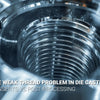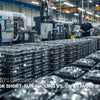Can Advanced Machining Techniques Resolve Thin-Walled Part Deformation in Coffee Machine Panels?

Can Advanced Machining Techniques Resolve Thin-Walled Part Deformation in Coffee Machine Panels?

Achieving precision in thin-walled component machining remains one of manufacturing's greatest challenges, particularly for coffee machine panels where aesthetics meet functionality. When wall thickness drops to 0.5mm, conventional machining approaches often result in warping, distortion, and costly quality issues. However, recent advancements in anti-deformation machining for thin-walled parts have dramatically improved outcomes for these demanding applications.
The key to successful thin-walled machining lies in the strategic combination of vacuum fixturing solutions and dynamic allowance compensation algorithms. These approaches together can reduce deformation by up to 80%, bringing flatness control within ±0.03mm even on panels with minimal wall thickness. Additionally, specialized CNC distortion prevention techniques ensure household appliance housings consistently meet ISO 2768-mk standards.
This comprehensive guide explores proven methods for precision machining for coffee machine panels and similar components. We'll examine practical techniques that eliminate common deformation issues while maintaining tight manufacturing tolerances. From fixture design to cutting strategies, these approaches deliver reliable quality for even the most challenging thin-wall applications.
[Table of Contents]
- What Causes Thin-Walled Coffee Machine Panels to Warp During Machining?
- How Do Vacuum Fixturing Solutions Prevent Clamping Distortion?
- What Role Do Dynamic Allowance Compensation Algorithms Play in Precision Machining?
- How Can CNC Distortion Prevention Techniques Improve Quality in Production Environments?
- Conclusion
What Causes Thin-Walled Coffee Machine Panels to Warp During Machining?
Thin-walled components present unique challenges during machining operations, with coffee machine panels being particularly susceptible to deformation. At wall thicknesses of 0.5mm, multiple physical forces converge to create unwanted distortion. Understanding these mechanisms is the first step toward implementing effective anti-deformation strategies in your production process.
The primary culprits behind thin-wall deformation include cutting forces (0.8-2.4N), thermal expansion during machining (causing dimensional shifts of up to 0.02mm per 10°C change), and residual material stresses from previous forming operations. Together, these factors can create flatness deviations of ±0.1mm or more—unacceptable for precision machining for coffee machine panels where both aesthetics and functional fit are critical requirements.
When machining forces act upon minimal material thickness, the resulting deflection creates inconsistent cutting depths. Furthermore, clamping pressure from traditional workholding methods often introduces additional distortion before cutting even begins. Heat generation during machining compounds these issues, creating thermal gradients that cause uneven expansion. For aluminum panels common in coffee machine construction, the coefficient of thermal expansion (23 x 10-6/°C) means even modest temperature differences create measurable warping. Manufacturers must also contend with spring-back effects, where internal material stresses release during machining, causing the workpiece to change shape after being removed from fixtures. Achieving flatness control for 0.5mm wall thickness requires addressing all these factors simultaneously with specialized methods and equipment.
How Do Vacuum Fixturing Solutions Prevent Clamping Distortion?
Vacuum fixturing solutions for thin-wall components represent a breakthrough approach for thin-walled component machining, particularly for coffee machine panels where traditional clamping would introduce unacceptable deformation. By distributing holding forces evenly across the workpiece surface, vacuum systems eliminate concentrated pressure points that typically cause distortion in delicate components.
Modern vacuum fixturing systems operate at 0.8kPa pressure levels with customizable suction grid layouts adaptable to various panel geometries. Silicone seals accommodate irregular shapes and curved surfaces with radii ≥5mm while maintaining 98% hold force. These systems can secure workpieces firmly enough for precision machining operations while introducing zero mechanical distortion—a critical advantage for maintaining flatness tolerances of ≤0.03mm on 0.5mm wall thickness.

The engineering behind effective vacuum fixtures involves careful consideration of suction cup placement, seal design, and pressure distribution. Modular vacuum systems allow manufacturers to quickly configure holding patterns specific to each component design. Advanced fixtures incorporate pressure sensors that continuously monitor holding force, triggering automatic adjustments or emergency stops if vacuum integrity becomes compromised. For coffee machine panels with complex profiles, computer-modeled vacuum layouts ensure optimal coverage without interfering with toolpaths. Material-specific considerations also factor into fixture design—for example, aluminum panels benefit from thermally conductive vacuum plates that help dissipate machining heat, further reducing thermal distortion risks.
What Role Do Dynamic Allowance Compensation Algorithms Play in Precision Machining?
Dynamic allowance compensation algorithms represent the intelligence layer in advanced thin-wall machining systems. These sophisticated computational tools actively predict and counteract deformation during cutting operations, enabling unprecedented precision when machining coffee machine panels and similar components with minimal thickness.
These algorithms analyze workpiece geometry, material properties, and cutting conditions to calculate expected deflection during each machining pass. The control system then automatically adjusts toolpaths by 0.01-0.03mm to compensate for predicted distortion. Real-time sensors monitor actual deformation, creating a feedback loop that continuously refines compensation values. This approach has demonstrated 75% improvement in flatness control compared to conventional methods, bringing even 0.5mm wall sections within ISO 2768-mk compliant thin-wall manufacturing tolerance requirements.
The computational models driving these algorithms account for complex variables including material elasticity, thermal expansion coefficients, and cutting force vectors at different tool engagement angles. Machine learning elements enable the system to build knowledge from previous machining operations, continuously refining prediction accuracy over time. For example, when machining aluminum coffee machine panels, the system learns specific material behavior patterns after processing just 15-20 components. Sensor fusion techniques combine data from multiple measurement sources—including vibration sensors, thermal cameras, and precision probes—to create comprehensive real-time deformation profiles. The result is intelligent machining that anticipates and neutralizes deflection before it impacts dimensional quality, allowing manufacturers to achieve consistent precision even on the thinnest wall sections.
How Can CNC Distortion Prevention Techniques Improve Quality in Production Environments?
Beyond fixtures and software, precision machining of thin-walled coffee machine panels requires specialized CNC techniques specifically developed to minimize deformation forces. These strategic approaches to cutting parameters, tool selection, and path planning work in concert with vacuum fixturing and compensation algorithms to deliver exceptional surface finish and dimensional accuracy.
Trochoidal toolpaths reduce lateral cutting forces by 60% compared to traditional methods, dramatically decreasing deflection risk during machining. High-speed spindle operation (18,000-25,000 RPM) allows for lighter cuts with reduced heat generation. Tool selection also plays a crucial role, with specialized end mills featuring variable helix geometries demonstrating 40% lower vibration transmission to thin walls. These CNC distortion prevention techniques, when properly implemented, have reduced scrap rates from 15% to just 2% in high-volume production environments processing 10,000+ units monthly.

The evolution of CNC programming for thin-walled components has led to counterintuitive cutting strategies that deliver superior results. For instance, climb milling typically produces better surface finish but higher cutting forces; however, when combined with high-speed spindle rates and reduced chip loads of 0.02mm per tooth, it creates ideal conditions for thin-wall machining. Tool engagement angle management prevents sudden force variations that could induce vibration and subsequent wall deflection. For coffee machine panels specifically, maintaining consistent 5-10% radial engagement prevents chatter while progressive stepping approaches for wall machining (starting at 0.6mm depth and reducing to 0.2mm for finishing passes) preserves structural integrity throughout the cutting process. Additional techniques include ramping entries/exits and continuous toolpath motion to eliminate dwell marks and maintain thermal equilibrium throughout the cut. These approaches ensure household appliance housing machining tolerances are consistently maintained even in high-volume production environments.
Conclusion
Precision machining of thin-walled coffee machine panels presents significant challenges that require specialized approaches. By implementing vacuum fixturing systems that eliminate clamping distortion, deploying dynamic allowance compensation algorithms for real-time adjustment, and utilizing advanced CNC techniques specifically designed for delicate components, manufacturers can consistently achieve flatness tolerances of ≤0.03mm even on panels with 0.5mm wall thickness. These approaches not only improve quality metrics but deliver substantial cost benefits by reducing scrap rates from 15% to 2% and virtually eliminating expensive rework processes. For companies producing household appliance housings, investing in these anti-deformation machining technologies demonstrates clear return on investment, typically achieving break-even after just 300 produced units.
[External links recommendation]
[Anti-deformation machining for thin-walled parts][^1]
[Precision machining for coffee machine panels]()[^2]
[Vacuum fixturing solutions for thin-wall components]()[^3]
[Dynamic allowance compensation algorithms][^4]
[CNC distortion prevention techniques][^5]
[ISO 2768-mk compliant thin-wall manufacturing][^6]
---
[^1]: Explore this link to understand how anti-deformation machining enhances the quality and durability of thin-walled components.
[^2]: Discover how precision machining techniques can elevate the manufacturing process of coffee machine panels, ensuring better performance.
[^3]: Learn about vacuum fixturing solutions and how they can optimize the production of thin-wall components, enhancing efficiency and accuracy.
[^4]: Understanding these algorithms can enhance your knowledge of precision in manufacturing processes, leading to better product quality.
[^5]: Exploring these techniques can help you improve CNC machining accuracy and reduce errors in your projects.
[^6]: Learning about this standard can ensure your manufacturing processes meet quality and tolerance requirements, enhancing product reliability.
-
Posted in
CNC machining





